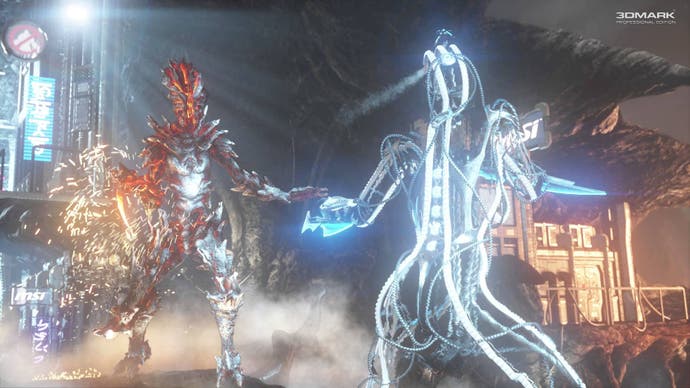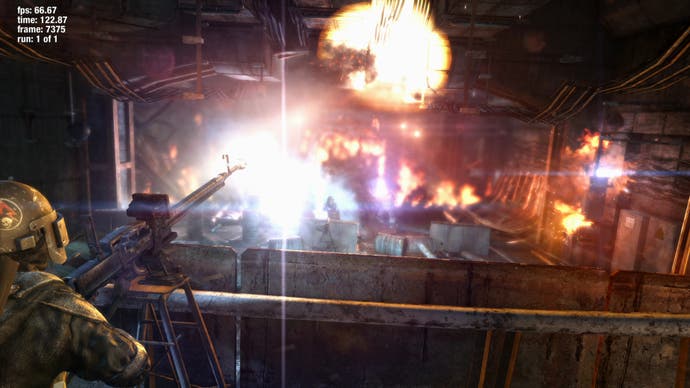Nvidia's next laptop graphics chip is a full, desktop-class GTX 980
Initial tests and benchmarks from Digital Foundry.
Once upon a time, not so long ago, Nvidia's GeForce GTX 980 was the fastest single-chip graphics processor on the market. And now, in a sense, it is again. This week, the company has announced that the GTX 980 has migrated across to the gaming laptop space, its hardware spec completed unaltered from its desktop iteration. According to the firm, a GTX 980 in the laptop form-factor is 35 per cent faster than the current performance king, the GTX 980M. Based on the hands-on benchmarking we carried out, the claims have merit.
So, what's the difference between the GTX 980 and existing GTX 980M for notebooks? It's no secret that laptop components that carry the same product name as their desktop equivalents, even when the performance differential is substantial. The current GTX 980M is based on the same processor as the desktop version - codenamed GM204 - but the CUDA core count drops from 2,048 to 1,536 while maximum 'boost' clock speeds are more limited: Nvidia's GPUs scale up frequency according to thermal and power limits, and obviously these are more constricted in a small laptop chassis. On top of this, memory speeds are also reduced too. It's easy to understand why - fewer cores at lower clocks combined with slower RAM still give a lot of performance, but the energy savings are substantial.
The GTX 980 for notebooks, described in some leaks as the 'GTX 990M', reverses all of these compromises. The full GM204 chip with the complete complement of shaders is available to gaming laptop users for the first time, and despite the thermal challenges, Nvidia reckons that at least we should see the same base clock as the desktop version (this may vary according to the chassis). Boost varies from game to game (and it's unlikely to fully match the desktop card here in all scenarios), but full 7gbps memory bandwidth is also confirmed - an area where pre-reveal leaked specs had suggested lower throughput. According to Nvidia, GTX 980 in a laptop should hand in performance within three per cent of its output in its more traditional desktop environment.
At a special briefing, the firm demonstrated this by running benchmarks simultaneously, side-by-side on both desktop and notebook iterations of the chip. The desktop computer took the form of a small form-factor PC running a Core i7 4770K processor, while the Clevo P870 laptop was actually the more powerful machine overall, sporting a more recent Skylake i7 (the desktop 6700K, no less). Benchmarks were rather limited, concentrating on two iterations of 3DMark, Unigine Heaven and three games with pre-scripted benchmark sequences: the original Metro Last Light, Tomb Raider and Shadow of Mordor.
Unfortunately, FCAT captures were ruled out for a granular look at performance - a shame bearing in mind we'd brought our MacBook Pro-based mobile capture set-up. But at the same time, we know these benchmarks well and all three of the games have at some point been a component of our own testing: and we can be confident that the differing CPU in the test set-ups will have limited impact on the overall results. So, let's look first at the 3DMark and Unigine Heaven results.

| Synthetics | Desktop GTX 980 | Laptop GTX 980 |
|---|---|---|
| 3DMark 11 Score | X5868 | X5923 |
| 3DMark 11 Graphics/Physics/Combined | 5510/ 9620/ 6752 | 5526/ 11011/ 6682 |
| 3DMark Firestrike Score | 5917 | 5908 |
| 3DMark Firestrike Graphics/Physics/Combined | 6290/ 11076/ 2762 | 6184/ 12797/ 2759 |
| Unigine Heaven Score | 1888 | 1883 |
| Unigine Heaven Min/Max/Age FPS | 29.8/ 159.8/ 75.0 | 30.0/ 159.4/ 74.7 |
Beginning with the two versions of 3DMark, graphics scores between both systems are effectively identical, with a maximum 1.8 per cent variance in favour of the desktop on the newer Firestrike benchmark. However, you will note that the physics tests see the laptop take a commanding 15 per cent lead over the desktop - and this is what tends to happen when you compare a more highly clocked modern Skylake i7 CPU with a two-year-old Haswell model.
The Unigine Heaven bench - set to DirectX 11 ultra settings with extreme tessellation and 4x MSAA - again points to parity in terms of graphics performance between the two test systems, with the desktop system offering just a 0.5 per cent improvement in score. This is basically irrelevant, sitting well within the margin of error. Thus far, the level of parity between the two systems is quite remarkable, but as you might expect, minor wrinkles arise when games are tested.
Perhaps not surprisingly, the Tomb Raider benchmark offers us no difference at all between the two test systems (it barely stresses CPU at all) but curious differences do manifest in Shadow of Mordor and Metro Last Light. The middle-earth title hits a minimum frame-rate snag on our first test run (38.0fps vs 65.8fps on desktop), which is mostly resolved on the second run (61.9fps vs 66.6fps). Metro Last Light shows the notebook GTX 980 handing in around 96 to 97 per cent of the desktop's performance overall, but actually sees higher minimum frame-rates, a scenario repeated on a second run. Without FCAT to give us context, it's a bit of a mystery at to why there is a difference, but any one of CPU, RAM or storage could be the issue - of all the three gaming benchmarks, Nvidia chose, only Metro was designed by the developers as an actual stress-test. It is also by far the longest gaming benchmark in the three chosen.

| Game Engine Benchmarks | Desktop GTX 980 | Laptop GTX 980 |
|---|---|---|
| Tomb Raider Min/Max/Avg FPS | 82.0/ 128.0/ 105.6 | 82.0/ 130.0/ 105.2 |
| Shadow of Mordor Test #1 Min/Max/Avg FPS | 65.8/ 128.9/ 93.59 | 39.1/ 127.1/ 88.8 |
| Shadow of Mordor Test #2 Min/Max/Avg FPS | 66.2/ 128.5/ 93.6 | 61.9/ 133.3/ 88.3 |
| Metro Last Light Test #1 Min/Max/Avg FPS | 28.0/ 148.8/ 85.1 | 38.0/ 152.4/ 83.6 |
| Metro Last Light Test #2 Min/Max/Avg FPS | 28.8/ 150.3/ 85.7 | 35.6/ 145.8/ 82.6 |
But regardless, while testing conditions aren't completely ideal, the weight of evidence suggests that the notebook GTX 980 is indeed a substantial leap, and it's interesting to note that hardware manufacturers are relying on their existing chassis designs to house the full-power GM204. For example, we've already reviewed a GTX 980M-powered MSI Dominator GT72. Soon, you'll be able to buy it with a Skylake CPU and the uncompromised GTX 980. The firm's beautifully insane Titan GT80 is also getting an upgrade.
Meanwhile, Asus is dialling up the mania to 11, with a full-on watercooling peripheral for its GX700 notebook. Nvidia is shipping the notebook GTX 980 unlocked, meaning that core and memory can be overclocked - though overvolting isn't likely to be implemented in the short term. Overclocking results are likely to vary between each notebook, and we wouldn't be surprised if there is some variance in the GTX 980's performance on a per-chassis basis. Nvidia tells us that the notebook GTX 980 only has a very slightly lower power draw than its desktop equivalent, meaning that equivalent amounts of heat have to go somewhere.
But whatever happens, the arrival of the full GTX 980 in the notebook space means that gaming performance in a mobile form-factor has been propelled onto the next level. Compared to the GTX 980M, the relative increase in performance is akin to the difference between GTX 980 and 980 Ti, perhaps even higher. We're currently reviewing the Asus G751JY - a beautiful gaming laptop combining the 980M with a G-Sync screen, and we put together a full 1080p performance breakdown to see how the older notebook performance flagship stacks up against Nvidia's range of enthusiast-level desktop GPUs. We see anything from a 22 to 36 per cent increase between the GTX 980M and the full-fat desktop part. Call of Duty Advanced Warfare actually registers a 52 per cent uplift - almost certainly because we hit CPU limits, where the i7 4790K comprehensively bests the laptop i7 4870HQ.
| 1920x1080 (1080p) | i7 4790K/ GTX 960 | i7 4790K/ GTX 970 | i7 4790K/ GTX 980 | i7 4870HQ/ GTX 980M |
|---|---|---|---|---|
| The Witcher 3, Ultra, HairWorks Off, Custom AA | 48.1 | 56.0 | 65.8 | 48.3 |
| Battlefield 4, Ultra, 4x MSAA | 48.6 | 74.6 | 86.5 | 64.4 |
| COD Advanced Warfare, Extra, Filmic SMAA T2x | 86.4 | 117.8 | 128.1 | 84.1 |
| Crysis 3, Very High, SMAA | 47.0 | 71.4 | 81.5 | 59.8 |
| Assassin's Creed Unity, Ultra High, FXAA | 26.6 | 51.7 | 62.4 | 49.6 |
| Far Cry 4, Ultra, SMAA | 50.8 | 77.4 | 87.4 | 64.2 |
| Shadow of Mordor, Ultra, High Textures, FXAA | 53.2 | 80.8 | 91.7 | 64.0 |
| Tomb Raider, Ultimate, FXAA | 65.7 | 102.4 | 118.2 | 77.7 |
There are still a few unknowns right now - specifically in terms of just fast the notebook GTX 980 boosts its core frequency, and the impact on that of more challenging thermal constraints - but assuming Nvidia's claims check out and we do see just a three per cent drop in performance compared to the desktop iteration, the results above paint a very interesting picture. The nips and tucks to the GTX 980M's spec impact performance in different ways, depending on the game. At best, it trades blows with the desktop GTX 970 - as we see in the Assassin's Creed Unity test. At worst, there are scenarios where performance is more on par with the GTX 960. However, for the most part, its performance profile pitches it at some point between GTX 960 and GTX 970.
That being the case, transplanting the top-end GTX 980 into the notebook space is a big deal. Based on our Asus G751JY and MSI GT72 testing, the GTX 980M is a worthy laptop gaming GPU - but with the arrival of the full-fat GTX 980, there's the potential here for a desktop replacement that offers far fewer performance compromises, doing so without the need for SLI. Doubtless, there will be a substantial premium to pay for the best of the best in notebook graphics, but this has always been the case and does not seem to have negatively impacted the top-end laptop space, which by all accounts continues to expand. The arrival of technologies like G-Sync is just as exciting as performance improvements: the adaptive refresh display of the G751JY really is a game-changer - more on that soon.
In closing, this new utilisation of GTX 980 is a well-judged move by Nvidia. In recent times, the desktop version has been sitting in something of a No Man's Land: the GTX 970 is much cheaper and via overclocking, it provides the majority of the stock 980's performance. Meanwhile, the arrival of the GTX 980 Ti has redefined the high-end to the 980's detriment: if you're spending $500 on a graphics card, why not save up $150 more and get the top-tier product? Squeezed from both directions, the desktop GTX 980 has lost some of its sheen. Propelled into the laptop space, it should be the absolute state of the art - something we look forward to checking out soon.


